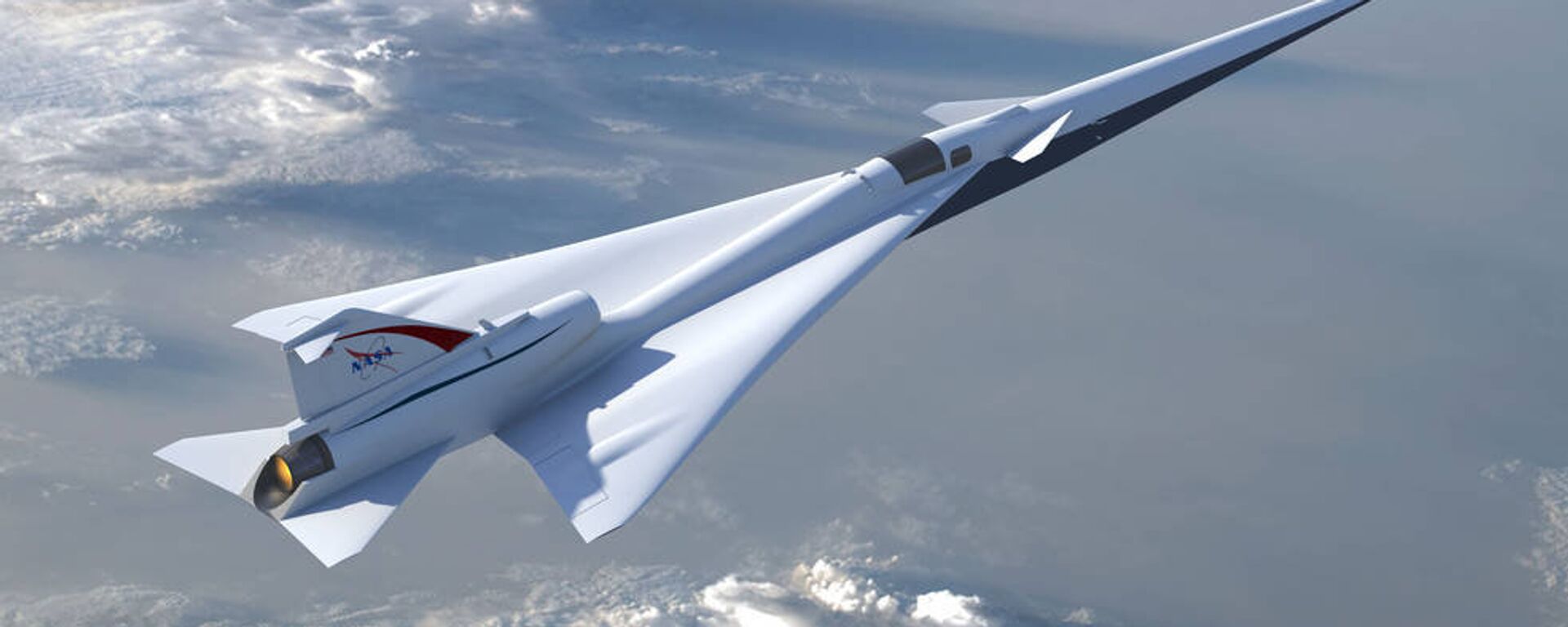https://sputnikglobe.com/20240105/nasas-experimental-x-59-plane-with-unique-feature-to-finally-make-debut-1116006300.html
NASA’s Experimental X-59 Plane With Unique Feature to Finally Make Debut
NASA’s Experimental X-59 Plane With Unique Feature to Finally Make Debut
Sputnik International
A fully-painted X-59 Quesst will finally see the light of day after almost six years of construction by Lockheed Martin in California.
2024-01-05T23:35+0000
2024-01-05T23:35+0000
2024-01-06T01:50+0000
beyond politics
us
science & tech
lockheed martin
concorde
tu-144
nasa
https://cdn1.img.sputnikglobe.com/img/07e5/0c/18/1091775673_0:67:1280:787_1920x0_80_0_0_72cd926257a4fe30cf7bdcb334ee1701.jpg
In the latter half of the 20th century the world briefly entered the age of supersonic travel with the debut of the Concorde and the Soviet Union’s Tupolev Tu-144. The technology was ultimately retired, but NASA hopes an experimental aircraft set to be unveiled next week will mark the return of the high-speed form of transport.A fully-painted X-59 Quesst will finally see the light of day after almost six years of construction by Lockheed Martin in California. Like the Concorde and Tu-144, the X-59 is designed to travel faster than the speed of sound, but with one key difference: engineers hope the quieter noise levels produced by the plane will overcome one of the key drawbacks of previous iterations of the technology.The aircraft produces less noise due to one key physical characteristic. A sharp, 38-foot nose on the front of the plane allows it to more easily slice through the air, reducing older supersonic planes’ characteristic ear piercing sonic booms to something more akin to the sound of slamming a car door.The unique feature is similar in intent to the long noses on Japan’s most recent high-speed trains, which are designed to lessen the noise they create when entering tunnels.Engineers hope the technology can usher in a new era of commercial supersonic transport, having addressed one of its key problems. Formerly, supersonic flights were forced to travel over unpopulated areas in order to not disturb people on the ground below.NASA plans to fly the X-59 over residential neighborhoods to see if the noise level created by the aircraft is acceptable. After that, they’ll seek regulatory approval to reinaugurate supersonic commercial flight.Novel technology will be key to the experimental plane’s operation in more ways than one. While supersonic planes previously maintained pilots’ forward vision by employing a “drooped” nose design, the X-59 has no such feature.In fact, it doesn’t even have windows on the front of the aircraft. Pilots will instead see ahead through the use of cameras transmitting video to the cockpit on an electronic screen.“Our goal is to create an electronic means of vision for the X-59 pilot that provides performance and safety levels equivalent to or better than forward-facing windows,” said Randy Bailey, a lead designer of the so-called eXternal Visibility System (XVS) technology.
https://sputnikglobe.com/20200207/nasas-experimental-x-59-supersonic-jet-to-be-complete-by-end-of-2020-1078258341.html
Sputnik International
feedback@sputniknews.com
+74956456601
MIA „Rossiya Segodnya“
2024
Sputnik International
feedback@sputniknews.com
+74956456601
MIA „Rossiya Segodnya“
News
en_EN
Sputnik International
feedback@sputniknews.com
+74956456601
MIA „Rossiya Segodnya“
Sputnik International
feedback@sputniknews.com
+74956456601
MIA „Rossiya Segodnya“
what is the x-59 quesst, examples of supersonic travel technology,
what is the x-59 quesst, examples of supersonic travel technology,
NASA’s Experimental X-59 Plane With Unique Feature to Finally Make Debut
23:35 GMT 05.01.2024 (Updated: 01:50 GMT 06.01.2024) A painted version of the aircraft will be publicly unveiled next week. Engineers hope one distinctive physical characteristic will usher in an age of quieter supersonic flight.
In the latter half of the 20th century the world briefly entered the age of supersonic travel with the debut of the Concorde and the Soviet Union’s Tupolev Tu-144. The technology was ultimately retired, but NASA hopes an experimental aircraft set to be unveiled next week will mark the return of the high-speed form of transport.
A fully-painted X-59 Quesst will finally see the light of day after almost six years of construction by Lockheed Martin in California. Like the Concorde and Tu-144, the X-59 is designed to travel faster than the speed of sound, but with one key difference: engineers hope the quieter noise levels produced by the plane will overcome one of the key drawbacks of previous iterations of the technology.
The aircraft produces less noise due to one key physical characteristic. A sharp, 38-foot nose on the front of the plane allows it to more easily slice through the air,
reducing older supersonic planes’ characteristic ear piercing sonic booms to something more akin to the sound of slamming a car door.
The unique feature is
similar in intent to the long noses on Japan’s most recent high-speed trains, which are designed to lessen the noise they create when entering tunnels.
Engineers hope the technology can usher in a new era of commercial supersonic transport, having addressed one of its key problems. Formerly, supersonic flights were forced to travel over unpopulated areas in order to not disturb people on the ground below.

7 February 2020, 23:00 GMT
NASA plans to fly the X-59 over residential neighborhoods to see if the noise level created by the aircraft is acceptable. After that, they’ll seek regulatory approval to reinaugurate supersonic commercial flight.
Novel technology will be key to the experimental plane’s operation in more ways than one. While supersonic planes previously maintained pilots’ forward vision by employing a “drooped” nose design, the X-59 has no such feature.
In fact, it doesn’t even have windows on the front of the aircraft. Pilots will instead see ahead through the use of cameras transmitting video to the cockpit on an electronic screen.
“Our goal is to create an electronic means of vision for the X-59 pilot that provides performance and safety levels equivalent to or better than forward-facing windows,”
said Randy Bailey, a lead designer of the so-called eXternal Visibility System (XVS) technology.
Although Westerners likely remember the French-Anglo Concorde jet, they may be unaware the Soviet Union was actually the first to unveil a supersonic plane.
The Tupolev Tu-144 made its maiden flight near Moscow in 1968, the year before the debut of the Concorde. The aircraft also went supersonic a full four months before the Concorde in 1969 and became the first commercial plane to achieve Mach 2 the following year.



